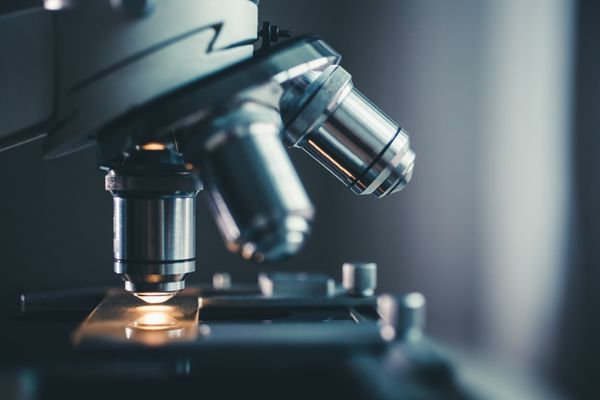1.1.1
Studying Cells - Microscopes
Magnification and Resolution
Magnification and Resolution
Two parameters that are important in microscopy are magnification and resolution.


Magnification
Magnification
- Magnification is the process of enlarging an object in appearance.
- The image size is how big the object appears to be in a picture or drawing, which will be in milimeters (mm).
- The actual size is often given in micrometers (µm) - units must be converted so that they are the same.


Calculating magnification
Calculating magnification
- The equation for magnification is:
- Magnification = size of image ÷ size of real object
- E.g. A mitochondrion is 20 µm long. An image of the mitochondrion is measured as 20 mm long. What is the magnification?
- Magnification = 20,000 µm ÷ 20 µm = 1,000x


Resolution
Resolution
- Resolution is the ability of a microscope to distinguish two adjacent structures as separate.
- The higher the resolution, the better the clarity and detail of the image.
Microscopes
Microscopes
It is important to understand the principles and limitations of optical microscopes, transmission electron microscopes and scanning electron microscopes.


Optical (light) microscopes
Optical (light) microscopes
- Visible light passes and is bent through the lens system to enable the user to see the specimen.
- The specimen can be alive.
- Individual cells are generally transparent and their components are not distinguishable unless they are coloured with special stains.
- Staining usually kills the cells.


Uses of light microscopes
Uses of light microscopes
- Most student microscopes are classified as light microscopes.
- Maximum resolution is 0.2 micrometres.
- The nucleus and mitochondria can be seen with a light microscope.
- The maximum magnification is around x1,500.


Electron microscopes
Electron microscopes
- In contrast to light microscopes, electron microscopes use a beam of electrons instead of a beam of light.
- This allows higher magnification and higher resolving power.
- This means that more detail can be seen.


Uses of electron microscopes
Uses of electron microscopes
- Electron microscopes have a maximum resolution of 0.0002 micrometres.
- This is around 1000 times more than light microscopes.
- The maximum magnification is around x1,500,000.
Types of Electron Microscopes
Types of Electron Microscopes
There are two main types of electron microscopes: transmission (TEM) and scanning (SEM) electron microscopes.


TEM
TEM
- In a TEM, the electron beam penetrates the cell and provides details of a cell’s internal structures.
- TEMs use electromagnets to focus the electron beam.
- TEMs are high resolution microscopes.
- In thin specimens, you can see the internal structures of organelles such as chloroplasts.


SEM
SEM
- In a SEM, a beam of electrons moves back and forth across a cell’s surface, creating details of cell surface characteristics.
- SEMs knock electrons off the specimen and these electrons come together to form an image.
- SEM images can be three-dimensional.
- Specimens do NOT have to be thin like when using a TEM.
- Resolution is lower than that produced by a TEM.
1Cell Structure
1.1Cell Structure
1.1.1Studying Cells - Microscopes
1.1.2Introduction to Eukaryotic & Prokaryotic Cells
1.1.3Ultrastructure of Eukaryotic Cells
1.1.4Ultrastructure of Eukaryotic Cells 2
1.1.5Ultrastructure of Eukaryotic Cells 3
1.1.6Prokaryotic Cells
1.1.7Viruses
1.1.8End of Topic Test - Cell Structure
1.1.9Exam-Style Question - Microscopes
1.1.10A-A* (AO2/3) - Cell Structure
2Biological Molecules
2.1Testing for Biological Modules
2.2Carbohydrates & Lipids
2.3Proteins
3Enzymes
4Cell Membranes & Transport
4.1Biological Membranes
5The Mitotic Cell Cycle
6Nucleic Acids & Protein Synthesis
6.1Nucleic Acids
7Transport in Plants
8Transport in Mammals
8.1Circulatory System
8.2Transport of Oxygen & Carbon Dioxide
9Gas Exchange
9.1Gas Exchange System
10Infectious Diseases
10.1Infectious Diseases
10.2Antibiotics
11Immunity
12Energy & Respiration (A2 Only)
13Photosynthesis (A2 Only)
14Homeostasis (A2 Only)
14.1Homeostasis
14.2The Kidney
14.3Cell Signalling
14.4Blood Glucose Concentration
14.5Homeostasis in Plants
15Control & Coordination (A2 Only)
15.1Control & Coordination in Mammals
15.1.1Neurones
15.1.2Receptors
15.1.3Taste
15.1.4Reflexes
15.1.5Action Potentials
15.1.6Saltatory Conduction
15.1.7Synapses
15.1.8Cholinergic Synnapses
15.1.9Neuromuscular Junction
15.1.10Skeletal Muscle
15.1.11Sliding Filament Theory Contraction
15.1.12Sliding Filament Theory Contraction 2
15.1.13Menstruation
15.1.14Contraceptive Pill
15.2Control & Co-Ordination in Plants
16Inherited Change (A2 Only)
16.1Passage of Information to Offspring
16.2Genes & Phenotype
17Selection & Evolution (A2 Only)
17.2Natural & Artificial Selection
18Classification & Conservation (A2 Only)
18.1Biodiversity
18.2Classification
19Genetic Technology (A2 Only)
19.1Manipulating Genomes
19.2Genetic Technology Applied to Medicine
19.3Genetically Modified Organisms in Agriculture
Jump to other topics
1Cell Structure
1.1Cell Structure
1.1.1Studying Cells - Microscopes
1.1.2Introduction to Eukaryotic & Prokaryotic Cells
1.1.3Ultrastructure of Eukaryotic Cells
1.1.4Ultrastructure of Eukaryotic Cells 2
1.1.5Ultrastructure of Eukaryotic Cells 3
1.1.6Prokaryotic Cells
1.1.7Viruses
1.1.8End of Topic Test - Cell Structure
1.1.9Exam-Style Question - Microscopes
1.1.10A-A* (AO2/3) - Cell Structure
2Biological Molecules
2.1Testing for Biological Modules
2.2Carbohydrates & Lipids
2.3Proteins
3Enzymes
4Cell Membranes & Transport
4.1Biological Membranes
5The Mitotic Cell Cycle
6Nucleic Acids & Protein Synthesis
6.1Nucleic Acids
7Transport in Plants
8Transport in Mammals
8.1Circulatory System
8.2Transport of Oxygen & Carbon Dioxide
9Gas Exchange
9.1Gas Exchange System
10Infectious Diseases
10.1Infectious Diseases
10.2Antibiotics
11Immunity
12Energy & Respiration (A2 Only)
13Photosynthesis (A2 Only)
14Homeostasis (A2 Only)
14.1Homeostasis
14.2The Kidney
14.3Cell Signalling
14.4Blood Glucose Concentration
14.5Homeostasis in Plants
15Control & Coordination (A2 Only)
15.1Control & Coordination in Mammals
15.1.1Neurones
15.1.2Receptors
15.1.3Taste
15.1.4Reflexes
15.1.5Action Potentials
15.1.6Saltatory Conduction
15.1.7Synapses
15.1.8Cholinergic Synnapses
15.1.9Neuromuscular Junction
15.1.10Skeletal Muscle
15.1.11Sliding Filament Theory Contraction
15.1.12Sliding Filament Theory Contraction 2
15.1.13Menstruation
15.1.14Contraceptive Pill
15.2Control & Co-Ordination in Plants
16Inherited Change (A2 Only)
16.1Passage of Information to Offspring
16.2Genes & Phenotype
17Selection & Evolution (A2 Only)
17.2Natural & Artificial Selection
18Classification & Conservation (A2 Only)
18.1Biodiversity
18.2Classification
19Genetic Technology (A2 Only)
19.1Manipulating Genomes
19.2Genetic Technology Applied to Medicine
19.3Genetically Modified Organisms in Agriculture
Unlock your full potential with Seneca Premium
Unlimited access to 10,000+ open-ended exam questions
Mini-mock exams based on your study history
Unlock 800+ premium courses & e-books